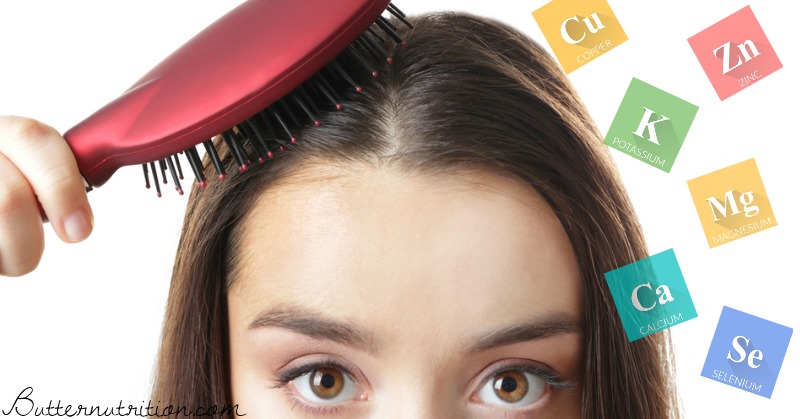
When I first tried hair tissue mineral analysis (HTMA), I have to admit I was a huge skeptic. While I’m no stranger to losing hair from coloring, breakage, and hair loss in my early twenties due to poor nutrition, purposely cutting off a piece of my hair at the root to send in for testing was a slightly different story. I was terrified even though it was only about one tablespoon of hair from the root, but I did it anyways. Now I’m here to tell you about it.
I tried out hair analysis testing for almost nine months before I was blown away by what I learned about the science of HTMA, my body, and the results I saw. There were certain health issues I’d seen 70-80% improvement with nutrition alone, but by using hair analysis to provide a glimpse of what was going on inside my body, I could actually see the mineral deficiencies and imbalances I needed to address. No more guessing or assuming! Once I knew what my deficiencies and imbalances were, I was able to target them with a specific supplement plan and see another 10-15% improvement pretty quickly. By this point I knew I had to study hair analysis myself and use it in my own practice—a service I just recently started offering.
Hair analysis is an absolute game changer for optimizing your nutrition and getting (and keeping) yourself out of nutritional debt. However, because supplements are a main part of the protocol (real-food supplements whenever possible), I do see it as “icing on the cake” to an already stellar, nutrient-dense diet. Because, let’s face it, you can’t supplement yourself out of poor eating habits.
What is hair analysis?
Hair analysis provides a unique snapshot into your body, showing you a stress and energy profile. A hair analysis can help indicate where you are on the energy continuum while assessing your mineral status. It can also detect imbalances sooner than blood tests identify them and show you early trends toward health problems.
I see hair analysis as a prevention tool of the future, examining and correcting mineral levels as an early line of defense against disease. Here are just a few studies that show correlations between certain hair minerals levels and disease:
- Hair Analysis and Cancer:
A 2014 study looking at hair mineral levels in 399 polish women revealed lower concentrations of selenium, zinc, copper, germanium and boron, iron, and magnesium along with an increased level of aluminum, potassium, and molybdenum in all of the cancer patient groups (digestive tract cancers, hormone-dependent cancers, and high glycolysis cancer) in the study when compared to the healthy control group. Based on these findings and others, the researchers concluded “that these trace elements in hair may be regarded as tumor biomarkers and prognostic factors for various cancer groups. Moreover, our results suggest that analysis of trace element levels should be taken into consideration to optimize prevention and may be helpful to individualize therapies of various cancers in women on the basis of the analysis of hair trace elements. All in all, our results allow for the conclusion that hair element analysis is useful in screening tests for the biomarkers of various cancer diseases in female populations.”[1] - Hair Analysis and Breast Cancer:
This study examining hair mineral levels of 40 newly diagnosed cancer patients prior to anti-cancer chemotherapy found that “Breast cancer patients had low calcium, magnesium, iron, copper, manganese, and zinc, whereas they had high arsenic, sodium, and potassium compared with the normal control.”[2] - Hair Analysis and Metabolic Syndrome or Syndrome X:
According to the Mayo clinic, Metabolic Syndrome is “a cluster of conditions that increase the risk of heart disease, stroke, and diabetes.” This study of 343 individuals showed that “the optimal calcium and magnesium concentrations in hair tissue may reflect decreased risk of metabolic syndrome, whereas high mercury concentration in hair tissue may indicate increased risk of metabolic syndrome.“[3]
How do mineral imbalances occur?
- Diet – Processed food, fad diets, eating too little, and depleted soil can all contribute to mineral imbalances.
- Stress – Stress causes your body to not only waste certain minerals, but also have difficulty absorbing and assimilating nutrients from your food.
- Medications – Medications can deplete your body of certain minerals.
- Nutritional supplements – Did you know that taking one mineral supplement can have a cascading effect on other minerals? Hair analysis can help to bring your mineral levels back in balance after abusing nutritional supplements.
- Environment/pollution – Throughout your lifespan, you’re exposed to countless toxins, particularly toxic metals like cadmium (cigarette smoke), lead (hair dyes, cosmetics), nickel (hydrogenated oils), aluminum (antiperspirants, cookware), mercury (amalgam fillings), and copper (cookware).
- Inherited imbalances – Mineral deficiencies and/or excesses can be inherited from your parents.
10 Things Hair Analysis Can Teach You
Enough of the back story of hair analysis testing! Today I want to share with you 10 of the most important things that hair analysis can teach you…[keep reading]
PIN IT:

